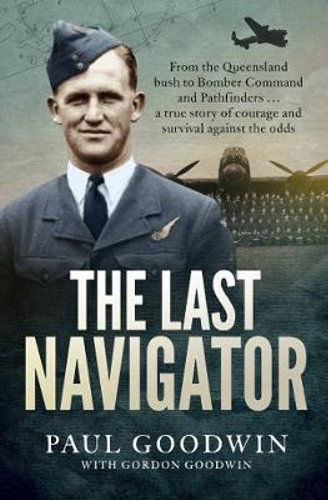This is a biography written as an autobiography. Paul Goodwin has written ‘in his (my father’s) voice, as it is his story’. Sentiments and feelings have been greatly enhanced by presenting the life of Gordon Goodwin in this format from his father’s memoirs and subsequent verbal elaboration in his final years; with research filling any ‘gaps’.

An independent and resourceful adolescent in a very small country town, Gordon suffered years of constant demands from a father who thought his own role in life was to be an overseer, After leaving school at 12 years of age, Gordon eventually took himself off to Bundaberg to work in a sugar mill and study the science of sugar refining. To help make ends meet he joined the local militia unit in 1939, training as a Vickers gun crew member. His uncle’s tales of conditions on the Western Front in the First World War, made joining the RAAF in 1940 a more attractive proposition. [Gordon’s militia colleagues were posted to 9th Division, and with the fall of Singapore, became prisoners of the Japanese.]
Whilst doing three-months basic training in Sydney, Gordon became fascinated by the navigational skills of Matthew Flinders. Then at 23 years-old he was off by sea to Vancouver for the second stage of the Empire Air Training Scheme. After training as a navigator/bomb-aimer at Edmonton’s Air Observers School he flew day and night navigational exercises. Next was followed by an eight-week course at the bombing and gunnery school followed by four weeks at Air Navigation School in Winnipeg to study astro-navigation.
The now Flight Sergeant Goodwin, qualified as observer/navigator, was posted to Atlantic Ferry Command. It took two flights in a Lockheed Hudson from Newfoundland to make it to Scotland in August 1941. At 27 Operational Training Unit in Staffordshire, crews were formed and commenced final training in Wellington Mark IV bombers before posting to No. 460 Squadron RAAF, RAF Bomber Command in Breighton, Yorkshire in March 1942. [The Lancaster ‘G-for-George’, now in the Australian War Memorial, flew in 460 Squadron.]
At the end of April, Gordon’s skipper invited him on a double date where he met his future wife Joy, who worked in London with Imperial Chemical Industries. Gordon’s seventeenth operation was over Cologne on 30 May 1942 and saw his squadron in Bomber Command’s 30 May 1942 and saw his squadron in Bomber Command’s first 1000-bomber raid. The incendiary results of the initial bombers providing guidance for those following led to the formation of Pathfinder units. Gordon flew 32 Pathfinder missions and 65 with Bomber Command. After his first tour (30 missions), he became a navigational instructor. Following a three-month Staff Navigator Course in April 1943, he formed a Navigation Instructors Course before returning to action with No. 7 Squadron Pathfinder Force. While on posting as navigation officer at the newly formed No. 635 Squadron, Gordon and Joy married in May 1944, with Joy experiencing a V1 ‘buzz-bomb’ strike on her parents’ home in August.
Gordon saw out the War as Chief Ground Instructor for Pathfinders in the early months of 1945. There was a call to London to consider a position as flight staff with Qantas after the war. He was soon on a six-day flight in a Qantas ‘civilianised’ Lancaster bomber on his way to Sydney and a ten-month separation from Joy. Gordon was finally ‘de-mobbed’ from the RAAF on 4 July 1945 and went on to spend the next 26 years with Qantas – the last thirteen of those as Chief Navigator. He flew in flying boats, Convair Constellations, Super Constellations, Boeing 707s and retired as 747 ‘Jumbos’ came into service. He worked on developing the computerised navigation systems for the latter aircraft.
Gordon, after making an incredible contribution to aviation navigation and Joy enjoyed their long retirement, with Gordon outliving the June 2012 unveiling in Britain of the memorial to Bomber Command statue by one month.
Paul provides an excellent Afterword. An insert of excellent black and white photographs from childhood through War to Qantas and Bomber Memorial is included. Paul has provided generous Endnotes that elaborate on his sources used outside his father’s memoirs Resume of the Life and Times of One R. Gordon Godwin (completed in 1997).
This work provides a superb insight into the role of the RAAF within the RAF Bomber Command. Eminently readable, it only took two sittings to complete a most enjoyable and enlightening experience.
Reviewed for RUSIV by Neville Taylor, June 2020
Contact Royal United Services Institute about this article.






